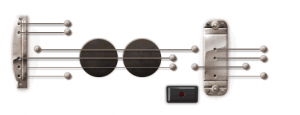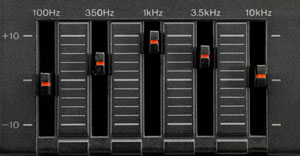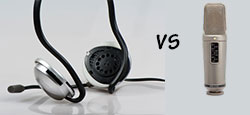Quiztones – http://quiztones.net/ has released an awesome iPhone app to help train your ears to recognize different audio frequencies.
Google Logo Is a Home Recording Studio Today
 We talk about virtual instruments in home recording all the time and today, the Google logo in honor of Les Paul’s birthday is BOTH a virtual instrument AND a mini audio recording studio!
We talk about virtual instruments in home recording all the time and today, the Google logo in honor of Les Paul’s birthday is BOTH a virtual instrument AND a mini audio recording studio!
If you missed this on the 9th and 10th of June, 2011, you can go to the permalink for it here: http://www.google.com/logos/2011/lespaul.html [originally said: Today is June 9th, 2011 and if you haven’t yet seen the Google logo for today, go here: Google.]
This is by far the coolest Google logo to date. You can strum or pick the guitar strings with your mouse. Each letter is a guitar chord already. So the logo itself is a virtual instrument, in this case a virtual guitar. But there’s another awesome little app on the logo, which is the record button. This thing actually works! Click on it to start recording. Then play the guitar strings with your mouse or touch-pad, and stop the recording. There will now be a “Play” button under the guitar that will play back the music you just recorded!
How freakin’ cool is that? It sort of summarizes the message we’ve been trying to broadcast, which is home recording in 2011 is inexpensive, easy and fun. To learn how you can do all sorts of nifty things like the Google logo just let you do, check out our many articles and resources at Home Brew Audio and get started having a blast in the next hour;).
See you there!
Ken
Complete Music Recording Studio for Under $600
 Here is my suggestion for the best way to put a music recording studio together for $600. Someone whose been using his brother’s home studio found out Bro was moving out and taking his gear with him. He had a budget of $600 and planned to mainly record acoustic, electric and bass guitars, and various virtual instruments like piano and other synths. This means he needed a decent mic and interface for the acoustic guitar and vocals, multitrack and editing audio software with midi capability. Here is how I answered his question:
Here is my suggestion for the best way to put a music recording studio together for $600. Someone whose been using his brother’s home studio found out Bro was moving out and taking his gear with him. He had a budget of $600 and planned to mainly record acoustic, electric and bass guitars, and various virtual instruments like piano and other synths. This means he needed a decent mic and interface for the acoustic guitar and vocals, multitrack and editing audio software with midi capability. Here is how I answered his question:
Hi Dave,
This is a great time to have to build you own set-up. I’m guessing that if your brother’s studio cost him thousands upon thousands of clams, he started building that up at least 7-10 years ago, am I right? Things are quite a bit more affordable now.
If you have a budget of 600 dollars, my recommendation would be this:
– Mic – Audio Technica AT 2035 – $149
– Interface – Focusrite Scarlett 2i2 – $149.99
– Software – Ableton Live Lite 8 Software – $0 since it comes bundled with the Scarlett. I would also throw in Reaper here, which you can also use for free as long as you’re evaluating it. Then you can buy it for $60 until you start making $20K per year with it.
– Guitar/Bass Interface – Line 6 POD Studio UX2 USB Computer Recording Interface: $195
For $494 you have a pro setup that will RAWK.
Later you’ll want to add more and different mics, more virtual instruments and effects, etc. And you’ll want to get some decent monitors as soon as the budget allows. But for now, kickin’ studio for under $600.00.
Hope that helps!
Cheers,
Ken Theriot
Is EQ Really Necessary?
 Someone asked this question over at the Home Recording Forum:
Someone asked this question over at the Home Recording Forum:
If you’re getting the right tone from the start when you record, for example using the tone control on the guitar and its amplifier, why is EQ needed in mixing? I’ve read a bunch of articles singing the praises of EQ, but in the mixes I made I didn’t touch it and they worked fine. I think I only used it once, to round off some top end on a guitar that was annoyingly bright.
Why is it considered so important?
I answered the question with the following:
You’re right about EQ’s necessity if you get the tones right at the source. Ideally it should not be needed, especially if you only have one or two tracks to deal with (say a voice over with some royalty-free music). Many folks over-use EQ to “fix” bad recording techniques. HOWEVER, in music recording, when you have multiple instruments playing together on multiple tracks, things can get muddied up pretty fast. Using EQ to assist in the mixing process becomes very important. The best mixes make room for every element to be heard, and without some EQ, certain instruments tend to mask each other by competing for the same frequencies. One common example is bass guitar and kick drum. They share many of the same frequencies and the best way to let them both be heard more clearly, you have to de-conflict key frequencies, reducing bass in one frequency area (letting the kick through), and reducing the kick in a different area (letting the bass through).
Hopefully that made sense. Basically, the more elements you have in a mix, the more likely you are to need EQ on individual tracks. But if you’re just doing, say, a voice over track, you shouldn’t need any EQ at all if you have a good recording space and decent signal chain.
Cheers!
Ken
Can You Tell The Difference Between a $5 and a $500 Mic?
When it comes to audio quality, there is no one true scale or score you can give to determine how professional sounding the audio quality is. It is mostly a matter of opinion. Oh sure, you can measure things like signal-to-noise ratio, or chart energy across a spectrum of frequencies. But at the end of the day what matter is what sounds better, and people can only be determine that with their ears. Often a bit of audio that has a low signal-to-noise ratio will also sound bad. Likewise with audio that has lots of distortion. But will that always be the case?
One other determination of audio quality is quality of gear. For instance, most folks will probably say that an expensive microphone will yield better audio quality than an inexpensive one; or that an expensive microphone pre-amplifier makes the difference. But will that, too, always be the case?
Let’s have you decide for yourself.
 I have two clips of audio for you to listen to. Both are voice over recordings. One was recorded with a $5.00 plastic PC mic plugged directly into the built-in sound card of a 6-year old standard PC. The other guy used a $300 studio microphone being fed through a $200 audio interface. So what we have are two clips of audio that on paper should be light-years apart in audio quality; essentially, one should sound 500 times better than the other, right? Well since the gear cost 500 times more, it may not be be 500 times better, but it should be really obvious shouldn’t it?
I have two clips of audio for you to listen to. Both are voice over recordings. One was recorded with a $5.00 plastic PC mic plugged directly into the built-in sound card of a 6-year old standard PC. The other guy used a $300 studio microphone being fed through a $200 audio interface. So what we have are two clips of audio that on paper should be light-years apart in audio quality; essentially, one should sound 500 times better than the other, right? Well since the gear cost 500 times more, it may not be be 500 times better, but it should be really obvious shouldn’t it?
Ready to hear these two clips? Okay, open our home page at: www.homebrewaudio.com and scroll to the middle of the page. You’ll see two flash players. Spoiler alert: Don’t read the text BELOW the players, since that will give the answer away.
Now listen to each sample. They’re only a few seconds long. Can you tell the difference between a $5 recording and a $500 recording? Regardless of the outcome, think about what this means in terms of the whole expensive-gear-always-sounds-better argument.
We’d be interested in hearing what your results were. Leave a comment!
Have fun.
Ken